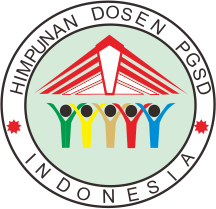Readiness Level of Elementary Schools in Berkoh Purwokerto Selatan, in Implementing E-Learning during the Pandemic
DOI:
https://doi.org/10.30595/dinamika.v14i1.11570Keywords:
E-Learning, Elementary School, Pandemic, ReadinessAbstract
Abstract. The Covid-19 pandemic has an impact on the world of education, namely the use of technology for learning. This study aims to determine the level of readiness of E-Learning in three elementary schools in the Berkoh Village. Survey research method, using a sample for the entire population. Participants come from the principal and teachers. The questionnaire instrument was used to measure the readiness to use learning technology, the readiness of infrastructure in schools, the readiness of school organizations, and additional information. Retrieval of data as much as 15 samples from 21 total populations. Data processing techniques and data analysis using descriptive statistical methods. From the four indicators of readiness, Of the four indicators of readiness coded into a readiness value. Results SDN 1 Berkoh Not ready needs a lot of work, SDN 2 Berkoh is Ready but needs a few improvement, and SDN 3 Not ready needs some of workReferences
[1] Aydin, C. H., dan Tasci, D. 2005. Measuring Readiness for e-Learning: Reflections from an Emerging Country. Educational Technology and Society, 8 (4), pp. 244-257
[2] Chapnick, Samantha. 2000. E-learning ReadinessTM Assessment. http://www.Researchdog.com.
Diakses tanggal 27 Mei 2021.
[3] Fariani, R.I 2013. Pengukuran Tingkat. Kesiapan E-Learning (E-Learning. Readiness): Studi Kasus pada Perguruan Tinggi ABC di Jakarta. Seminar Nasional Aplikasi Teknologi Informasi (SNATI).
[4] Henki dkk, 2016. Analisis Pengukuran Tingkat Kesiapan Implementasi E-Learning (E-Learning Readiness). Universitas Pembangunan Nasional Veteran Jakarta
[5] Ishikawa, Kaoru. 1968. Guide to Quality Control (Japanese): Gemba No QC Shuho. JUSE Press, Ltd., Tokyo
[6] Permendiknas No.16 Tahun 2007. Standar Kualifikasi Akademik dan Kompetensi Guru. Jakarta: Seketariat Negara.
[7] Priyanto. 2008. Model E-Learning Readiness Sebagai Strategi Pengembangan E- Learning. International Seminar Pro- ceedings, Information and Communication Technology (ICT) In Education. The Graduate School. Yogyakarta State University.
[8] Sugiyono. 2006. Metode Penelitian Kuantitatif, Kualitatif dan R &. D. Bandung:Alfabeta.
[9] Yudi Prayudi. 2009. Kajian Awal: E-Lear- ning Readiness Index (ElRI) Sebagai Model Bagi Evaluasi E-Learning Pada Sebuah Institusi. Prosiding Seminar Nasional Aplikasi Teknologi Informasi 2009. Yogyakarta.
[10] Zulfiana Farista. 2007. E-readiness Assesment sebagai langkah Awal Implementasi E-Government di Kabupaten Lombok Timur. Lombok Timur.
[11] Waryanto,Nur Hadi dan Nur Insani. 2013. Tingkat Kesiapan (Readiness) Implementasi E-Learning Di Sekolah Menengah Atas Kota Yogyakarta. Jurusan Pendidikan Matematika FMIPA UNY. Yogyakarta.
Published
How to Cite
Issue
Section
License
Authors who publish with this journal agree to the following terms:
Authors retain copyright and grant the journal right of first publication with the work simultaneously licensed under a Creative Commons Attribution License that allows others to share the work with an acknowledgement of the work's authorship and initial publication in this journal.
Authors are able to enter into separate, additional contractual arrangements for the non-exclusive distribution of the journal's published version of the work (e.g., post it to an institutional repository or publish it in a book), with an acknowledgement of its initial publication in this journal.
Authors are permitted and encouraged to post their work online (e.g., in institutional repositories or on their website) prior to and during the submission process, as it can lead to productive exchanges, as well as earlier and greater citation of published work (See The Effect of Open Access).

Dinamika Jurnal Ilmiah Pendidikan Dasar is licensed under a Creative Commons Attribution 4.0 International License.














